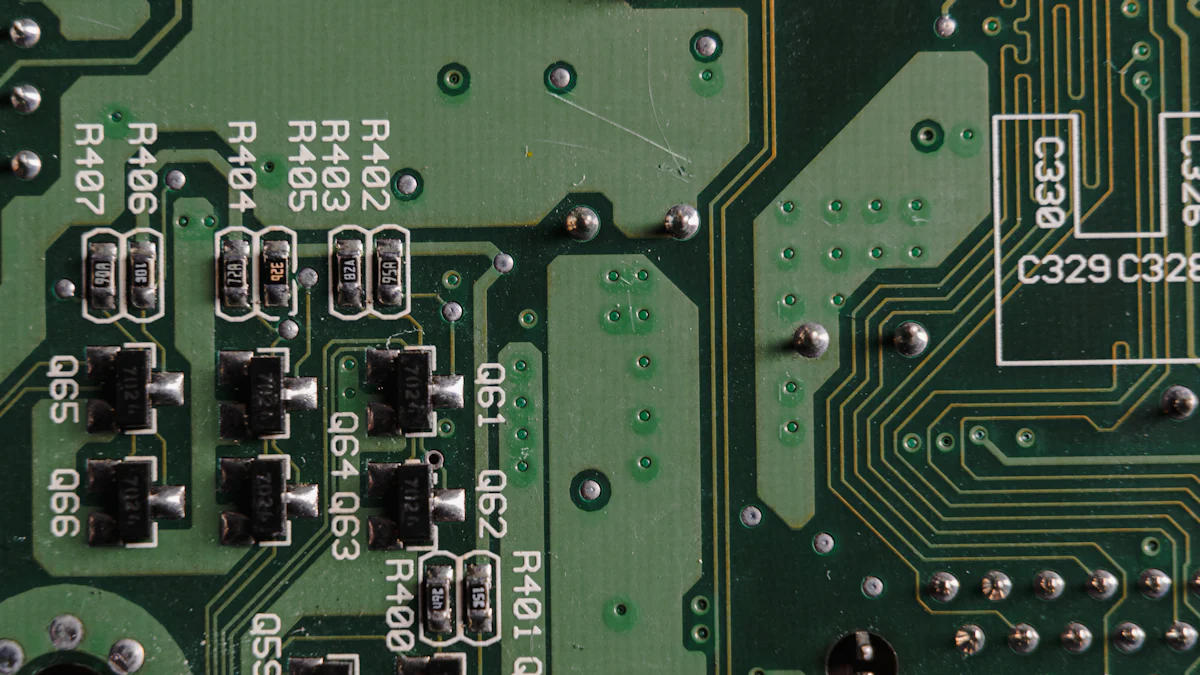1k Resistor Decoded: A Beginner’s Guide

A 1k resistor, often asked as "What is a 1k Resistor? 1k Ohm Resistor Color Code," is a fundamental component in electronics with a resistance of 1,000 ohms. Its resistance and tolerance are identified by its color bands, typically brown, black, red, and gold. This color code system allows for quick identification of its specifications without the need for additional tools.
Understanding the 1k Ohm Resistor Color Code is essential for beginners in electronics, as it simplifies the process of identifying components and helps prevent errors in circuit design. For instance, a resistor with yellow, violet, red, and gold bands represents 470 ohms with a tolerance of ±10%.
1k resistors are widely used in various applications, such as:
Current limiting in LEDs to prevent damage from excessive current.
Pull-up or pull-down resistors to stabilize signal lines.
Protecting microcontroller pins during connections.
Familiarity with "What is a 1k Resistor? 1k Ohm Resistor Color Code" enhances your ability to design and troubleshoot circuits effectively.
Key Takeaways
A 1k resistor has 1,000 ohms of resistance. Its colors are brown, black, red, and gold.
Learning resistor color codes is important for beginners. It helps avoid mistakes in circuits.
Use a color code chart to find resistor values fast. This helps you prevent errors.
The last color band shows how much the resistance can change. For a 1k resistor, it is ±5%.
Always double-check the resistor value with a digital multimeter. This ensures it is correct.
Good lighting and tools like a magnifying glass make reading colors easier.
Practice reading resistors with different colors to get better and faster.
Correct resistor values keep circuits working well and stop overheating or damage.
What is Resistor Color Coding?

Resistor color coding uses colored bands to show resistor details. These bands tell the resistance, tolerance, and other features of a resistor. This system removes the need for printed text. It helps identify resistor values on tiny components. Learning this system is important for working with electronics. It ensures circuits are designed and fixed correctly.
The Purpose of Resistor Color Codes
The color coding system helps identify resistor values quickly. In the 1920s, each manufacturer used different labeling methods. This caused confusion and mistakes. The Radio Manufacturers Association (RMA) created a standard color code. It became popular in the 1930s with radio technology growth. Over time, it became an international standard for electronics.
Color codes have many benefits:
They make resistor identification faster and easier.
Colored bands show resistance, tolerance, and wattage without text.
This system reduces mistakes and improves circuit reliability.
Learning resistor color coding saves time and avoids errors when using resistors.
How Resistor Color Codes Work
Resistor color codes use bands painted on the resistor. Each color stands for a number or multiplier. Read the bands from left to right. The first two or three bands show main numbers. The next band shows the multiplier. Extra bands may show tolerance or temperature changes.
For example, a resistor with brown, black, and red bands equals 1,000 ohms. Brown means "1," black means "0," and red is a multiplier of 100. Multiply these to get the resistance value.
This system is great for small resistors where text is hard to print. The color bands last long and stay readable even after years of use.
The Standardized Resistor Color Code Chart
To read resistors, use a resistor color code chart. This chart helps match colors to their values. Follow these steps:
Look at the first three bands for main numbers.
Use the chart to find the values of these colors.
Check the fourth band for the multiplier to add zeros.
Calculate resistance: Resistance (Ω) = (1st digit × 100 + 2nd digit × 10 + 3rd digit) × Multiplier.
The fifth band shows tolerance, or how accurate the resistor is.
The sixth band shows how resistance changes with temperature.
Description | |
|---|---|
3-band | First two bands show main numbers, third shows multiplier. |
4-band | Adds a tolerance band to show resistor accuracy. |
5-band | Adds more precision with extra significant digit and tolerance band. |
6-band | Includes a band for temperature changes in resistance. |
Using this chart helps you pick the right resistors for circuits. This skill is useful for beginners and experts. It improves accuracy and prevents mistakes in building circuits.
Understanding the 1k Ohm Resistor Color Code
What is a 1k Resistor? 1k Ohm Resistor Color Code
A 1k resistor is a fixed resistor with 1,000 ohms resistance. It helps control current and voltage in circuits. Its value is shown using the resistor color code system. This system uses colored bands to show the resistor's details. It removes the need for printed text, making it easier to read on small parts.
For a 1k resistor, the color bands are:
Brown: Stands for the number "1".
Black: Stands for the number "0".
Red: Shows a multiplier of 100.
Gold: Means a tolerance of ±5%.
These bands help you find the resistor's value and tolerance fast. You don’t need extra tools. The table below shows the color bands for a 1k resistor:
Band Position | Color | Meaning |
|---|---|---|
1st | Brown | 1 |
2nd | Black | 0 |
3rd | Red | Multiplier x100 |
4th | Gold | Tolerance ±5% |
This simple system helps you pick the right resistor for your circuits.
The Color Bands for a 1k Resistor
The color bands on a resistor show its resistance and tolerance. For a 1k resistor, the first two bands (brown and black) are the digits "1" and "0". The third band (red) is the multiplier, meaning you multiply the digits by 100. This gives a resistance of 1,000 ohms.
The fourth band (gold) shows the tolerance, or how much the resistance can vary. A gold band means ±5%, so the resistance can be between 950 ohms and 1,050 ohms. This range ensures the resistor works well in most circuits.
Knowing these color bands helps you choose the right resistor. It prevents mistakes that could cause circuit problems or inefficiency.
The Role of the Tolerance Band
The tolerance band is the last color band on a resistor. It shows how accurate the resistor is. For a 1k resistor with a gold band, the resistance can vary by ±5%. This means the resistance could be from 950 ohms to 1,050 ohms.
This variation is normal because resistors are not perfectly exact. The tolerance band tells you the acceptable range of resistance. This is important for keeping circuits working properly. For example, in a voltage divider, even a small change in resistance can affect the voltage output. By understanding the tolerance band, you can pick resistors that fit your needs.
In precise circuits, you might see resistors with tighter tolerances, like ±1% or ±2%. These are used in devices needing high accuracy, like medical tools. But for most circuits, a 1k resistor with ±5% tolerance works fine.
Tip: Always check the tolerance band when choosing a resistor. It helps your circuit work as expected and avoids performance issues.
Step-by-Step Guide to Decoding a 1k Resistor

Identifying the Color Bands
To figure out a 1k resistor, look at its color bands. These bands show the resistor's value and tolerance. A 1k resistor has four bands: brown, black, red, and gold. Each band means something specific:
The first band (brown) stands for "1".
The second band (black) stands for "0".
The third band (red) is the multiplier, meaning multiply by 100.
The fourth band (gold) shows ±5% tolerance.
Hold the resistor so the gold band is on the right. This helps you read the bands in the correct order. If you're unsure about the colors, use a resistor color code calculator. It makes decoding easier and avoids mistakes.
Using the Resistor Color Code Chart
A resistor color code chart helps match colors to values. To use it:
Find the colors of the first two bands. These are the main digits.
Look at the third band to find the multiplier. This tells how many zeros to add.
Check the fourth band for tolerance. This shows how much the resistance can vary.
For example, with brown, black, red, and gold bands:
Brown = 1 (first digit)
Black = 0 (second digit)
Red = x100 (multiplier)
Gold = ±5% (tolerance)
This method helps you pick the right resistor and avoid circuit problems.
Calculating the Resistance Value
After finding the color bands, calculating resistance is simple. Follow these steps:
Look at the resistor and note the band colors.
Match the first two band colors to their digits using the chart.
Multiply these digits by the third band's multiplier.
Add the results to get the resistance value.
For a 1k resistor:
The first band (brown) equals "1".
The second band (black) equals "0".
The third band (red) means multiply by 100.
So, the calculation is:1 (first digit) + 0 (second digit) x 100 (multiplier) = 1,000 ohms or 1k ohm.
The gold band shows ±5% tolerance, meaning the resistance can range from 950 to 1,050 ohms. This method ensures accurate decoding without special tools. You can also use a resistor calculator to double-check your work.
Tip: Practice decoding resistors with different colors. This will help you get faster and more confident. It's a useful skill for building and fixing circuits.
Checking the Decoded Value
After figuring out the color bands on a resistor, you should check if the resistance you calculated is correct. This step helps avoid mistakes and keeps your circuit working well. Here are some simple ways to check:
1. Use a Digital Multimeter
A digital multimeter (DMM) is a handy tool for checking resistor values. Follow these steps:
Turn the multimeter to the resistance (Ω) setting.
Touch the multimeter probes to the resistor ends. Polarity doesn’t matter.
Look at the resistance value on the screen.
Compare this number to your decoded result. For a 1k resistor, the multimeter should show close to 1,000 ohms. Small differences may happen because of the resistor’s tolerance.
Tip: Make sure the resistor is not part of a circuit when testing. Other parts can affect the reading.
2. Use an Online Resistor Calculator
Online resistor calculators are quick and easy to use. Enter the color bands into the calculator, and it will show the resistance value. This is helpful if you’re still learning or want to double-check your work.
3. Compare with a Known Resistor
If you have a resistor with a known value, compare it to the one you decoded. Place them side by side and see if their color bands match. This visual check can confirm your decoding.
4. Consider Tolerance
Don’t forget to include the tolerance band when checking the value. For a 1k resistor with a gold band (±5%), the resistance can range from 950 ohms to 1,050 ohms. Any value in this range is fine.
Tolerance Band | Acceptable Range for 1k Resistor |
|---|---|
Gold (±5%) | 950 Ω to 1,050 Ω |
Silver (±10%) | 900 Ω to 1,100 Ω |
Why Checking Matters
Checking the decoded value makes sure your resistor works properly in the circuit. Wrong resistance can cause problems, overheating, or damage to other parts. Taking time to check improves safety and reliability in your projects.
Note: Practicing these methods will make you better at decoding and checking resistors. Over time, you’ll get faster and more confident with resistor values.
Common Mistakes and Tips for Accurate Decoding
Misreading the Color Bands
Beginners often misread resistor color bands. Poor lighting makes colors like red and orange hard to tell apart. Black and brown can also look similar. This leads to wrong resistance values and circuit problems. Reading from the wrong end of the resistor can also cause errors. For four-band resistors, start reading near the edge or opposite the tolerance band.
To avoid mistakes, work in bright light. Use LED lights or daylight bulbs to see colors better. If the bands are tiny or blurry, use a magnifying glass. Keep a resistor color code chart nearby for quick checks. Digital tools or apps can also help with decoding.
Tip: Always double-check the color band order before calculating resistance. This simple habit prevents costly circuit errors.
Confusing the Multiplier Band
The multiplier band is key to finding the total resistance. Beginners sometimes mix it up with the digit bands. This can cause big calculation mistakes. For example, confusing a red multiplier (×100) with a red digit (2) changes the value by 100 times.
To decode it correctly, use a resistor color code chart. This chart shows the exact value for each color. In four-band resistors, the multiplier is always the third band. If unsure, use an online resistor calculator to confirm your result.
Note: Practice decoding resistors with different multipliers. Over time, you’ll get better and make fewer mistakes.
Ignoring the Tolerance Band
The tolerance band shows how much the resistance can vary. Ignoring it can cause circuits to fail or work poorly. For example, a gold band means ±5%, so a 1k resistor could range from 950 to 1,050 ohms. Skipping this detail might ruin precision circuits.
Always check the tolerance band when decoding. In four-band resistors, it’s the last band, usually gold or silver. For high-accuracy circuits, pick resistors with tighter tolerances like ±1% or ±2%. If unsure, use a digital multimeter to measure the resistance and confirm it’s within range.
Reminder: Knowing the tolerance band helps your circuit work properly, especially in precision tasks.
Tips for Avoiding Errors
Reading resistor color codes might seem hard at first. But with some simple tips, you can decode them correctly and easily.
1. Use Good Lighting
Bright light helps you see resistor colors clearly. Dim light can make colors like red, orange, and brown look alike. Use a bright lamp or sunlight to see better. If it’s still hard, try using a magnifying glass to see the bands more clearly.
Tip: Hold the resistor so the last band (gold or silver) is on the right. This way, you’ll read the bands in the right order.
2. Keep a Color Code Chart Nearby
A color code chart is very helpful for decoding resistors. It shows what each color means. Print one out or save an online version to use when needed.
3. Check Your Work Twice
Mistakes happen if you rush. After figuring out the color bands, double-check your answer. Use a digital multimeter to measure the resistor’s value. This ensures your result matches the actual resistance.
Reminder: A 1k resistor with a gold band should measure between 950 and 1,050 ohms. If it doesn’t, the resistor might be damaged.
4. Try Online Tools
If you’re unsure, use online resistor calculators. These tools let you enter the colors and give you the resistance value instantly. Some apps also have pictures to help you match the bands.
5. Practice with Different Resistors
The more you practice, the better you’ll get. Start with resistors that have clear colors. Then, try decoding ones with faded or hard-to-see bands. Practice will make you faster and more accurate.
Common Mistakes | How to Fix Them |
|---|---|
Misreading color bands | Use bright light and a magnifying glass. |
Mixing up the multiplier | Check the chart and confirm the third band’s value. |
Skipping the tolerance band | Always check the last band to know the allowed resistance range. |
Not verifying the value | Use a multimeter or online tool to confirm your result. |
Note: Careful decoding saves time and avoids mistakes in your projects.
By following these tips, you’ll get better at decoding resistors. Accurate decoding helps your circuits work properly and prevents errors. Keep practicing, and you’ll master this important skill in no time.
Why Resistor Color Coding Matters in Electronics
Why Accurate Resistance Values Are Important
Correct resistance values are key for circuits to work well. Resistor color coding helps you find these values fast without special tools. The color bands are strong and stay clear even in tough conditions. This makes them important for keeping circuits running smoothly.
When you read resistor values correctly, your circuit becomes more reliable. It lowers the chance of mistakes and makes fixing easier. For example, using the wrong resistor value can cause parts to overheat or fail. Learning the color coding system helps you avoid these problems and keeps your circuits working properly.
To decode a resistor:
Match the first band to its number for the resistance.
Use this to design accurate circuits.
This simple process is crucial for getting the right resistance, which affects how well your circuits perform.
How Resistor Color Coding Helps Circuit Design
Resistor color coding makes designing circuits easier and faster. You can quickly figure out resistor values without needing fancy tools. In busy places like workshops, the color bands let you pick the right resistor without wasting time.
The system follows a global standard (IEC60062), so it works everywhere. This makes it easy to use resistors from any manufacturer. It also helps with fixing circuits. You can check resistor values and tolerances to find and replace broken parts easily.
Using this system reduces mistakes when building or fixing circuits. Whether you're starting a new project or repairing an old one, resistor color coding ensures you choose the right parts quickly.
Benefits for Beginners
Resistor color coding is very helpful for beginners in electronics. It helps you pick the right resistors, so your projects work as planned. When fixing circuits, you can find and replace bad resistors quickly, saving time and effort. This is especially useful when repairing devices, as it makes finding broken parts simple.
It’s also a great way to learn. It teaches you how to read resistor values and use them in circuits. If you like DIY electronics, this system is a must. It lets you build anything from basic LED setups to more advanced designs with confidence.
By learning resistor color coding, you gain a skill that helps you design, fix, and improve circuits. This knowledge boosts your confidence and makes your projects better.
Tip: Practice reading resistors with different color bands. This will help you get better and faster at working with electronic parts.
Knowing how to read resistor color codes is important in electronics. It helps you find resistor values correctly, making circuits work better. By learning what each color band means and how they are arranged, you can easily identify parts and avoid mistakes in designs.
Practicing color code reading often is key to getting better. Start by finding the first two bands for main numbers, the third for the multiplier, and the fourth for tolerance. Use good lighting and tools like a magnifying glass to see clearly. Regular practice will make you faster and more accurate.
Getting good at this skill improves your electronics projects. It helps you design circuits well, fix problems easily, and make them more reliable. Whether you're new or experienced, using memory tricks and practicing often will lead to better results in your projects.
FAQ
1. What does the "1k" in a 1k resistor mean?
The "1k" means the resistor has 1,000 ohms of resistance. The "k" stands for "kilo," which means 1,000. This shows how much the resistor slows down the flow of electricity in a circuit.
2. How do I identify a 1k resistor using color codes?
Check for four color bands: brown, black, red, and gold. Brown and black mean "1" and "0," red is the multiplier (×100), and gold shows ±5% tolerance. These colors confirm the resistor is 1,000 ohms.
3. Why is the tolerance band important?
The tolerance band shows how much the resistor's value can change. For a 1k resistor with a gold band (±5%), the resistance can be between 950 and 1,050 ohms. This ensures it works properly in your circuit.
4. Can I use a multimeter to check a resistor's value?
Yes, you can use a digital multimeter to measure resistance. Set it to the resistance (Ω) mode and touch the probes to the resistor ends. The value on the screen should match the color code, including its tolerance range.
5. What happens if I use the wrong resistor value?
Using the wrong resistor can cause problems in your circuit. It might overheat, give the wrong voltage, or damage parts. Always check the resistor's value with color codes or a multimeter before using it.
6. Are resistor color codes the same worldwide?
Yes, resistor color codes follow a global standard called IEC60062. This makes it easy to identify resistor values no matter where they are made.
7. What tools can help me decode resistor values?
You can use a color code chart, online calculators, or apps. These tools make decoding easier by matching colors to values. A digital multimeter is also helpful to check resistance.
8. How can I avoid mistakes when reading resistor color codes?
Use bright light to see the colors clearly. A magnifying glass can help with small resistors. Always start reading near the edge or opposite the tolerance band. Double-check your results with a multimeter or online tool.
Tip: Practice reading resistor codes often to get better and faster.
See Also
Easy Steps to Effectively Test a Zener Diode
Essential Circuit Board Parts Every Newbie Must Understand
Comprehensive Tips for Selecting the Right Car Relays
How to Calculate and Understand Potentiometer Loading Mistakes
Important Differences Between CR1620 and CR2032 Batteries in 2025
